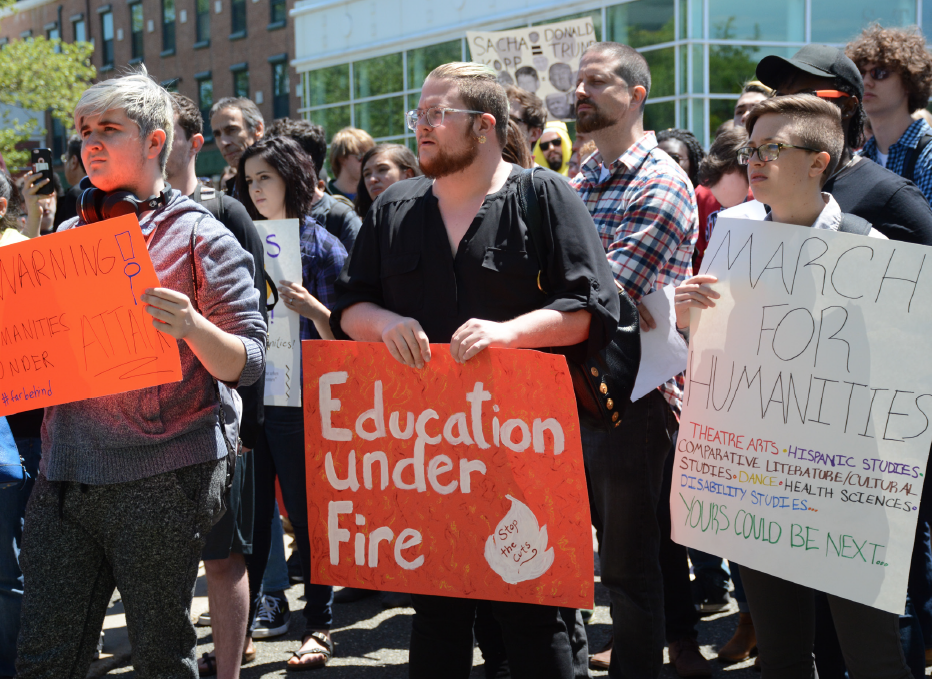The end of the spring semester is the apex of the collegiate year. Countless all-nighters fueled by energy drinks and caffeine binges have led to this point. While you cram and cultivate all the information you can, only a few final exams stand between you and summer vibes. All students, those returning next fall and those moving on appreciate that three month hiatus where the brain can take some time off. It is meant to be a break, an opportunity for relaxation and regaining composure. For many at Stony Brook, it won’t be.

On Friday, April 28, Sacha Kopp, Dean of the College of Arts and Sciences, announced that the Theatre Arts Department would be subject to widespread cuts in funding, becoming a service-only department. Current majors and minors will finish out their degrees, but no new students will be admitted, and many faculty members will be fired. The department will exist only to supplement Stony Brook’s diverse education learning initiative, SBC requirements.
The same night as the cut was announced, history major and advocate for the arts Alexandra Zigomalas started a petition on change.org titled “Protect the Department of Theatre Arts and Stony Brook University,” and emailed Kopp, President Sam Stanley and Provost Michael A. Bernstein. The petition currently sits at just under 3,000 signatures.
“I was enraged and appalled by the news,” Zigomalas said. “It doesn’t make sense and it isn’t fair. I’m a proud student of the arts.”
Of the three, only Bernstein replied to Zigomalas.
“We are engaged in a major strategic planning exercise in the College of Arts and Sciences,” Bernstein wrote. “-and, while no final decisions have yet been made, our goal will be to focus on what is best for the College and our University.
Since then, even more programs and departments are being threatened with cuts and consolidations. On Monday, May 1, Dean Kopp emailed the Department of Hispanic Languages and Literature alerting them that the doctoral program in Hispanic Studies would be “suspended” and the undergraduate program merged with European Studies. A similar petition to the one Zigomalas started is now live on change’s website as well, currently sitting at 3,400 signatures.

“What we are facing is for our department to be eliminated, that is 0.6% of the budget,” Mark Pingree, PhD student at the Comparative Literature and Cultural Studies department said. “I was informed, like most of the people at my department, through an email from the chair. He was just really broken from the tone of the email. He had no idea that our department would be dissolved- there was no conference about it, no warning, nothing.”
Pingree is still on his way towards completing his graduate degree and explained that the graduate students had a meeting with their chair right after the news got out. “Junior faculty members are worried if their tenure tracks will be affected and which institute will take them and some grad students were saying things like ‘I should probably get out of here- it seems like a toxic place now.”
On Wednesday, May 10, students, faculty, alumni and hundreds of others gathered in protest outside the Student Activities Center to march against the cuts. People dressed in banana suits and a spectrum of colored signs chanted as they walked down the academic mall, down the Administration steps and wrapped around the Staller Center, the resident center of the arts on campus.
Filling the Melville Library auditorium and working up to the third floor of the library, where Dean Kopp’s office is located, the crowd grew larger and louder. The third floor hallway filled with protesters. “Hey hey, ho ho, Sacha Kopp has got to go,” broke out consistently along the protest, all the way from the SAC to Kopp’s office door.
“Face your students!”
“We want education, not administration!”
“Do your job, Sacha Kopp!”
As occupants of the hallway’s demands echoed, Chief of Police Robert Lenahan and Deputy Chief Bruce Redder posted themselves outside of the Dean’s office with the door locked and additional officers inside. Lenahan declined to comment, but maintained conversation with protest organizers. Transparency, however, lacked.
Rachel Rodriguez, communications manager, attempted to quell the crowd, offering to take any information they had and bring it to the dean.
“He’s going to be in meetings all day long,” Rodriguez said. “He’s busy.”
Jeers and chants erupted as Rodriguez was unable to reach the crowd. Comparisons to Kellyanne Conway rose among the noise, which Rodriguez did not visibly appreciate.
“Excuse me?” Rodriguez responded. “That was very clever.”
Despite initial communications that Dean Kopp was considering meeting with a delegation of three representatives from the affected departments, that offer was quickly
rescinded and Rodriguez was left to deal with the crowd.
Over a hundred protesters, gathered in the hot hallway that was beginning to smell of body odor, chanted and picketed until organizers decided progress would not be made here. The march was led over to the administration building, where Provost Michael Bernstein’s office is located.
Ryan Hunter, a graduate assistant in the office of the Dean of College of Arts and Sciences, was locked in the office while the protests occurred outside. Dean Kopp, who was in his office the entire time and supervised by University Police, refused to invite representatives into his office to talk or step outside to face the protest.
“One of the big issues not being talked about here is that even the students who finish out their degrees in these departments aren’t benefitting,” Hunter said. “The degrees won’t mean much when the programs are discontinued.”
The march made its way in and out of administration and over to the Charles B. Wang Center to disrupt a private donor event.
At the end the protest had dwindled down to mere tens of people Passion for the arts is clearly present. But pure passion only goes so far. Dean Kopp never faced his students, nor did Provost Bernstein. It would be impossible to say they were unaware of the presence, as the hallways shook and roars of protesters echoed through the buildings.

The same line has been tossed around since this ambush announcement of cuts: “No final decision has been made yet.”
But in reality, that is untrue. Announcing these cuts at the end of the semester as they did is strategic, not coincidental. It’s a Kopp-out.
Kristen Spencer jokes that she switched majors from journalism to theater arts in part to escape the vexation she felt from everyday news. She hasn’t been as successful as she’d hoped.
“I’ve had friendships end because of discussions about this administration,” Spencer, a junior, said. “At the end of the day, if you support an administration that doesn’t care about me, then what exactly are you saying about our friendship?”
Among other issues, Spencer is concerned with the threats to arts funding proposed by the new executive branch. “I would love for the funding to remain untouched, it’s
heartbreaking, but in some ways I understand why,” she added.
Cuts have been proposed to federal Arts and Humanities programs in past presidencies, but no administration has ever proposed completely defunding them. Until now.
On Thursday, March 16, President Donald Trump released a preliminary 2018 budget proposal that would cut the entirety of the National Endowment for the Arts and the National Endowment for the Humanities $148 billion budgets, in addition to the $445 billion dedicated to the Corporation for Public Broadcasting. The larger scope of the cuts suggests that all federal arts and cultures agencies, making up just under $1 billion of the budget, will be cut by 100 percent.
Despite it’s reputation for STEM and research, Stony Brook University is a still a popular destination for the Arts and Humanities in New York state. 1,328 students enrolled are Humanities majors, tallying 7.1% of the over 25,000 students Seawolves, the 6th largest grouping on campus but 3rd when grouping all STEM fields together. In the SUNY system, the Humanities is actually the largest group, with close to 90,000, or 29 percent, attending 64 campuses.
The Pollack/Krasner House, the home of preserved artists Jackson Pollack and Lee Krasner, was a beneficiary of a $107,000 grant from the NEA for preservation purposes in 2003. The house now serves as a museum and study center devoted to scholarship in modern art, and falls into the category of the art department’s allocated budget. Only a portion of annual NEA funds go towards the $120,000 yearly upkeep of the house now, but without the initial grant, it may have never been.
“It’s a sad testament,” Helen Harrison, the director of the house, said about the cuts. “It hurts. Words fail me.”
Additionally, there are currently a total of 20 combined grant and fellowship opportunities students and faculty can apply for through the University’s College of Arts and Sciences, all of which would be defunded if the budget is approved.
Norman Prusslin is a professor, the Director of the Media Arts Minor and a faculty advisor to student media at Stony Brook University. He has watched the world of arts and Humanities grow since the establishment of the endowments in the ‘60s. He, too, hasn’t seen a proposition like this in his time.
“A high majority of Republicans and Democrats agree that these programs should stay,” Prusslin said.
“The National Endowment for the Arts is one of those rare organizations that allocates money to every congressional district. The two [NEA and NEH] combined make up less than $1 of everyone’s federal taxes.”
“A bigger issue here is not how significant the removal of arts and Humanities grants could be, but the additional implications. Federal dollars are often leveraged with state and local funding, almost like incentives to give money to programs,” Prusslin said.
Federal funding for the Humanities department is unclear in the text of the University Operating Budget, but according to the National Endowment for the Humanities grant database, three Stony Brook professors are currently receiving or have received federal funding for research this semester, and seven total in the last three years.
Prusslin feels that it is very possible that these massive cuts won’t occur and that it is “still early in the process and fair to discuss,” but the departments are already filled with a silent tension.
The Student New Works Festival hosted by the theatre department is a competition showcase that allows students to pitch, write, direct and create their own short plays. The plays ran from Thursday, April 27 to Sunday, April 30. For some, over a year’s worth of planning went into the performances.
The opening Friday of the festival, students in the department, celebrating their major and their semester long efforts, were emailed by the chair of the department, John Lutterbie, that they would be the last.
“With everything going on with the festival, I’ve actually been a bit more distracted from the news, but it hurts,” Spencer added.
Giselle Maronilla
Advocates for the Humanities have taken up various media in order to express their warranted concern over the school’s recent budget cuts. Whether they be petitions holding thousands of signatures, emphatic dialogues on social media or written articles imbued with powerful poetics, efforts to rescind the suspension of certain disciplines have united Stony Brook University students by way of their shared passion for the liberal arts.
And yet there remains one more agent responsible for solidifying the bond between students, faculty and alumni. Like cornstarch thickening an apple pie, Dean Sacha Kopp of the College of Arts and Sciences has become the universally-accepted bulls-eye of criticism. In response to his email regarding the suspension, merging, and cutting of the Humanities, the masses have unified not only through a love for the arts, but also through a scrutiny of the Dean himself. While outright slander has yet to emerge, almost every written or vocal appeal for the liberal arts has either begun or ended its petition with a direct address to the Dean. Out of a band of men and women responsible for these institutional changes, Dean Sacha Kopp has been made the leader to run the show and now, to run the gauntlet.
However, could it be possible that Dean Kopp is more innocent than deemed? Have Stony Brook students, despite the necessity of their endeavors, wrongfully assigned this man the role of a scapegoat? After all, according to Dr. John Lutterbie, chair of the Theater Department, the power to allocate funds truly resides with the state government, not the Stony Brook University council elite. Among the written and physical protests, the statistics-backed arguments and initiatives, the justified and needed emotions… wouldn’t the blame lie in the icy hands and shriveled hearts of the state legislators? Perhaps protesters are wasting their energy, attempting to fight the words of a Dean – rather than combating the decisions of the real lawmakers in Albany. Perhaps by simultaneously beseeching and castigating Dean Kopp, defenders of the Humanities and the Arts are only shooting the messenger.
Despite the admirable compassion embedded in these sentiments, Dr. Kopp is neither scapegoat nor messenger. Sacha Kopp of the College of Arts and Sciences is exactly as is stated: the Dean of the College of the Arts and Sciences. Therefore, as is implied by his appellation alone, Sacha Kopp is the governing head of a student body. More than a mere messenger, he must stand for and amplify the voice of the college, of which he has claimed responsibility for. Hence, it is the Dean’s duty to protect the needs of the student body and the right of the students to expect nothing less from their Dean. In spite of these requisites, Stony Brook U.’s leader of the College of Arts and Sciences has remained silent on an issue regarding the cancellation of Arts programs: an issue that catastrophically impacts his own microcosm. With the exception of a single email, in which the possible changes in academics are briefly outlined, justified (in ‘favor’ of the students), and laconically apologized for, Sacha Kopp has neither spoken of nor spoken for those affected by the legislature. In fact, the latest email sent out by Dr. Kopp highlighted not the pressing problem, but an anecdote relating to the experience of finals exams. (Yes Mr. Kopp, while finals exams are a nightmare for most, the budget cuts have made reality hell for many others).
Although not responsible for the budget cut itself, Dr. Kopp is responsible for supporting the rights of his students, no matter how arts-related or scientific their endeavors be. He has yet to prove his capabilities and loyalties. He has yet to march to the beat of the college’s drum. And until Sacha Kopp emerges from his silence not just as the herald but truly as the leader of this humanitarian movement, students have every right to ask with urgency,
“Where is Dean Kopp?”
Nirvani Williams
While the administration hacks away at the theatre department like it’s eating their entire 4.6 million dollar budget, Dr. John Lutterbie, Chair of Theatre Arts Department, remains a bastion of hope like the calm before the storm. In an interview, Dr. Lutterbie disclosed that a number of chairs in the department are forming subcommittees in order to find different approaches to the problem rather than the draconian budget cuts continually focused on the Arts and Humanities.
Lutterbie believes that this is a much more positive approach to the cuts rather than getting angry or resisting, which he says, “entrenches the administration.” Unfortunately, the ebbs and tides in the humanity and theatre budget started almost a decade ago when Stony Brook’s old president started subtly chipping away at the Humanities and theatre department funding. However, the university’s popular and well-know STEM programs were kept afloat while the Humanities programs were reduced to slowly suffer their dues.
Lutterbie watched the administration shift from bad to worse as President Stanley and the rest of the administrative board exemplified that they only really care about the money with the proposed budget cut. He understood that the decision to make Stony Brook the primary STEM school out of the SUNY system was made long before he arrived, but he also acknowledged that STEM students were creating exceptional work.
However, Lutterbie was, by no means, admitting defeat. He just has the daunting task of maneuvering and navigating in a shark tank where he would be considered the small fish. Lutterbie said that he thinks the administration should probably be doing more and he wishes that he received more support. Yet, he understands that every department wants just as much support as he does.
Honestly, Dean Kopp’s condescending email to the student body was simply insulting. Stony Brook claims that they want to cultivate a diverse student body, and, hey, guess what? Humanities and arts students do indeed add to the lovely experience of meeting peers who aren’t just biology or chemistry majors. Coming in contact with the wide range of students who sing, dance, act, compute, draw, build, and innovate is the Stony Brook experience I want to maintain and sustain on campus.
So, Stony. Let’s start focusing on what matters again. The reason everyone is here in the first place is so they can find their passion. Give students the opportunity to be an astrophysicist or an a capella singer. That freedom is what weaves together a happy, healthy, and fulfilling campus. This is what makes students feel proud to yell out “I’m a Seawolf!” This is why alumni will look back at their undergraduate experience and donate graciously to the school that helped them grow.
Let’s change the conversation from cut to create. How can we create an avenue for the theatre department to thrive as well?





Comments are closed.